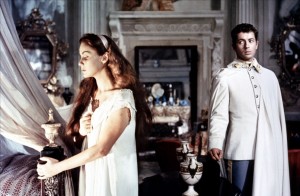 Review: One Screening Only
Review: One Screening Only
Senso | Luchino Visconti | Italy | 1954 | 123 min
UW Cinematheque (Chazen Museum), Sunday, October 4, 2:00pm»
Edwanike Harbour looks at Senso (1954), the visually gorgeous, emotionally compelling and politically controversial classic from Luchino Visconti.
Luchino Visconti (Rocco and His Brothers) was born into one of Northern Italy’s richest families and was a member of the Italian aristocracy as a son of the Duke of Modrone. This gave him some special insight into the themes of class and the social structure of Italy. Hailed as one of the most romantic films of its day, Visconti’s Senso (1954) is a sweeping love story gone awry. Controversial in its time for its portrayal of the Italian army and the ruling classes, Senso offers a close examination of sex, class, and gender in 1860s Venice. The movie is passionate, daring, and utterly beautiful.
The opening scene takes place inside the famed La Fenice, one of the most beautiful opera houses ever built. People have always attended the opera to see and be seen. In La Fenice, the seats are stacked right on top of one another all the way to the ceiling so everyone on each tier can also be on full display. The occupying Austrian army officers have seats on the floor close to the stage. Up above, protestors throw down fliers and call for an end to the occupation. During this fracas, a young man challenges an Austrian soldier to a duel. The Countess Livia Serpieri (Alida Valli) recognizes her cousin Roberto Ussoni as the offending Venetian and searches for an Austrian officer to put an end to the impending duel. Thus begins the steamy affair between the Countess and Franz Mahler (Farley Granger).
The story is one that many women are familiar with: a young cad charms his way into a woman’s heart only to lead her to destruction and ruin. The Countess allows herself to be wooed by this cowardly ingrate and only thinks of herself while putting her country at risk for a torrid sexual affair. Some of the scenes remain difficult to watch some 60 years after the film’s release. The sad, deluded Countess searches for Mahler when he fails to meet at their rendezvous, and she discovers that his fellow soldiers make light about the fact that he has duped so many women into believing that he loves them. The Countess was cool, calm, and collected at first and we begin to believe that she can resist his charms. Now we see a lonely, desperate, married woman willing to sacrifice everything for this good-for-nothing loser.
The casting Valli and Granger for the roles was an interesting choice. Alida Valli was supposed to be the “next Garbo” but never quite achieved that level of recognition despite her beauty and talent. She was perfect for this role as she was cool, aloof, dark, and brooding. According to Roger Ebert, Visconti initially wanted Marlon Brando as Gustav Mahler, but as this character called for someone for less intestinal fortitude, Brando would have been miscast in this role to be sure. Granger was an excellent choice as a well-known American star who had already had break out performances in such roles in Strangers on a Train and Rope.
The costumes are gorgeous and the Austrian soldiers’ uniforms are particularly striking. The stark white coats and sky blue pants tied together with their knee high black boots and a yellow band around the neck reminds one of today’s bugle and drum corps. The Countess frequently wears black clothing in public, almost suggesting a state of mourning. The bright and bold colors seem to intimate characters in an opera and this is no accident. Everything she holds dear may be crumbling around her.
We rarely see what the Countess’ relationship with her husband is really like. We see the passion between the Countess and Mahler but Visconti does not take a lot of time to establish why the Countess would be so unhappy with her spouse. Clearly, the Count is not a young, virile officer like Mahler, but to risk the safety of her family and her country is quite selfish. The Count suspects something and follows the Countess one evening to spy on her, but even when confronted with a confession of infidelity, he refuses to believe his wife could betray him in such a way. Viewers may feel the Countess gets what she deserves in the end, even though Mahler treats her in a despicable manner.
As the battle between the Italians and the Austrians takes place, it is not the central focus of the film. There are a few brief fighting scenes toward the end but ultimately, this is a tragic love story. This becomes distracting as it seems Visconti was trying to squeeze some of the final battle scenes into the movie to remind viewers that a war is still taking place. Ebert explains that the Italian government was not thrilled about showing the Italian army losing a battle so some of these scenes had to be truncated. Farley Granger and Visconti actually had a falling out before the film could be finished and Visconti had to use a double for Granger in the final frame. Visconti also portrays the ruling aristocracy in a less than favorable light as they treat the working class in an inhumane way. The deleted scenes may be beneficial for a 2 hour and 3 minute run time but it does leave some of the ending feeling rushed and unfinished.
The cinematography is beautiful with its rich color palette and wonderful Italian vistas. Opera fans will surely enjoy this movie and even if you are not inclined to appreciate steamy romantic films, the pace and direction of this film make it worth a viewing. The story arc and finishing touches all come together in a lush, moving, emotional story that a wide audience can appreciate.